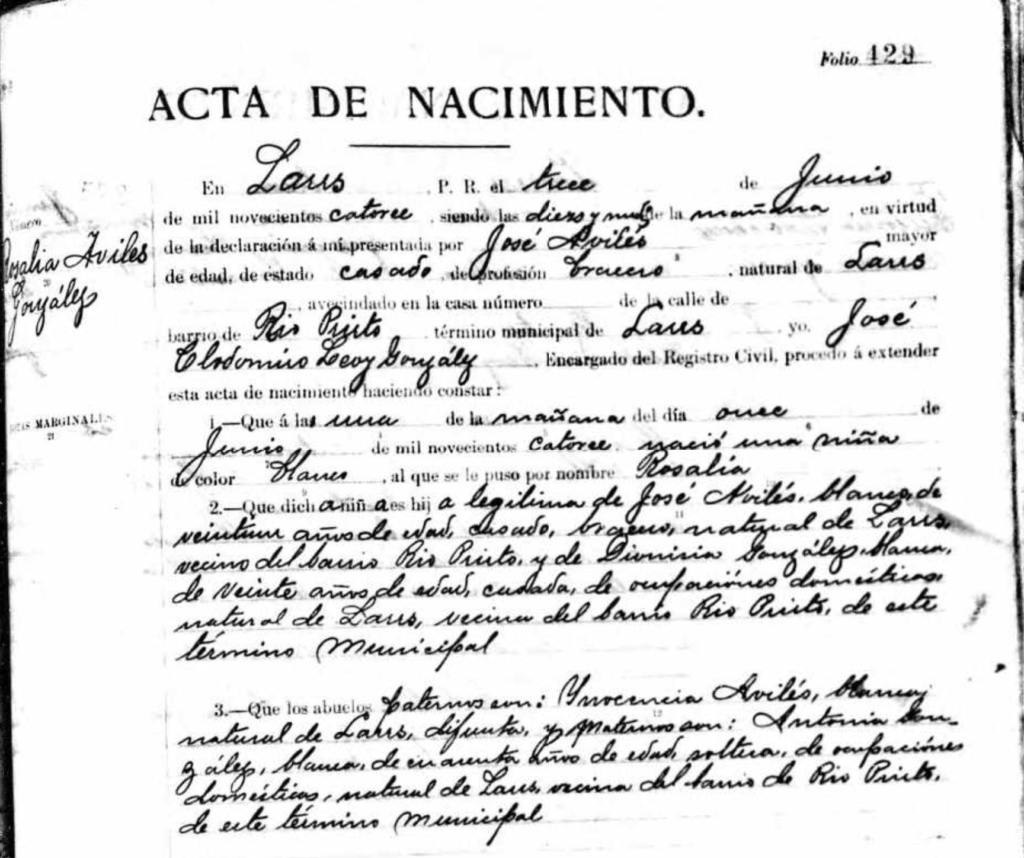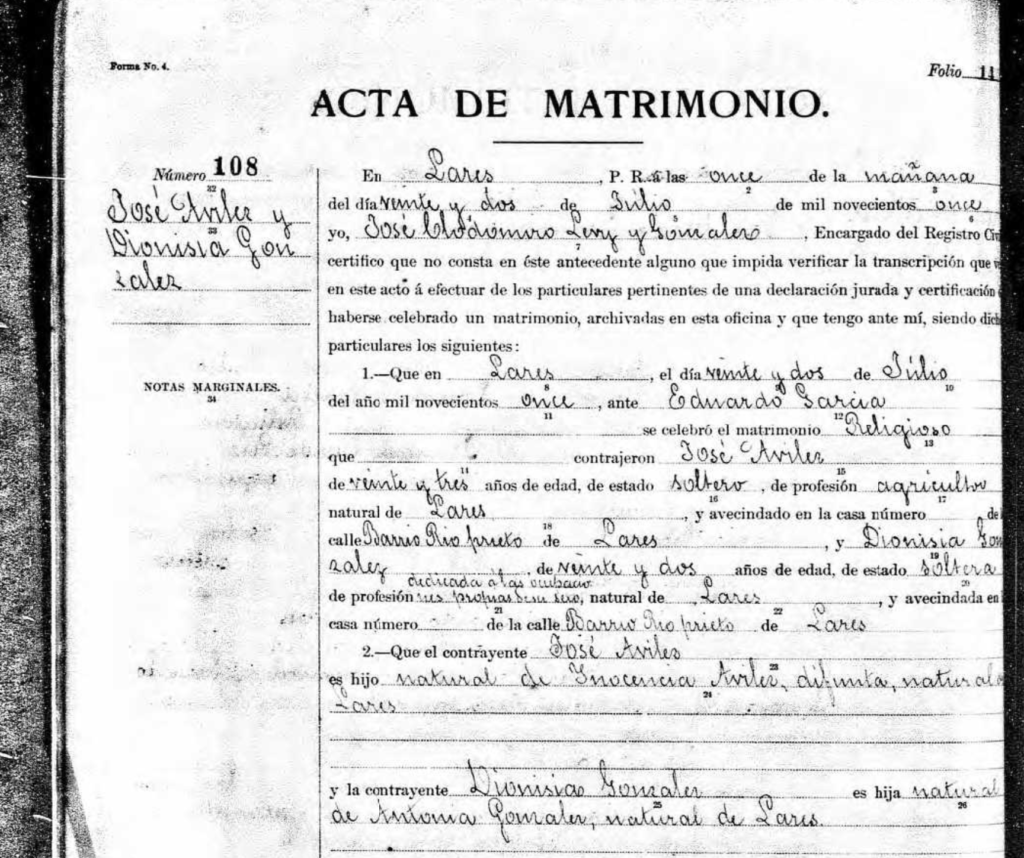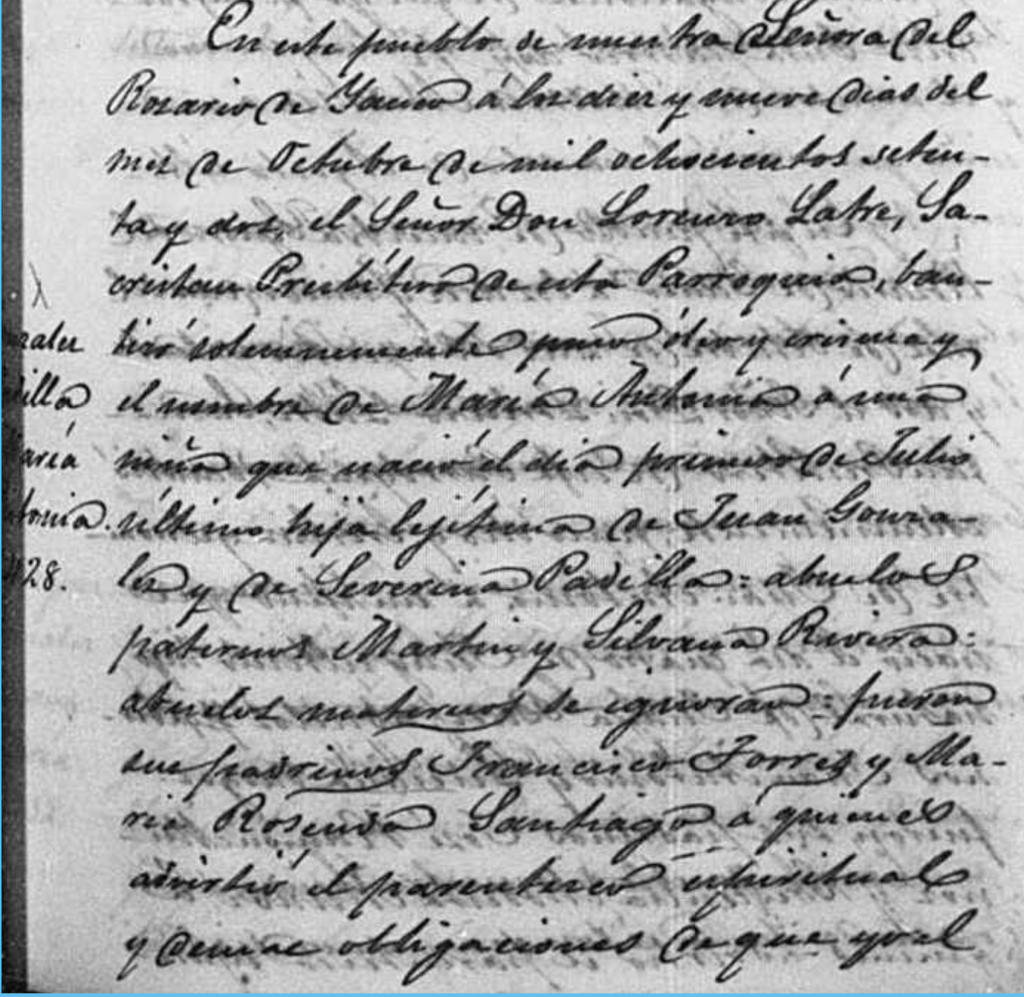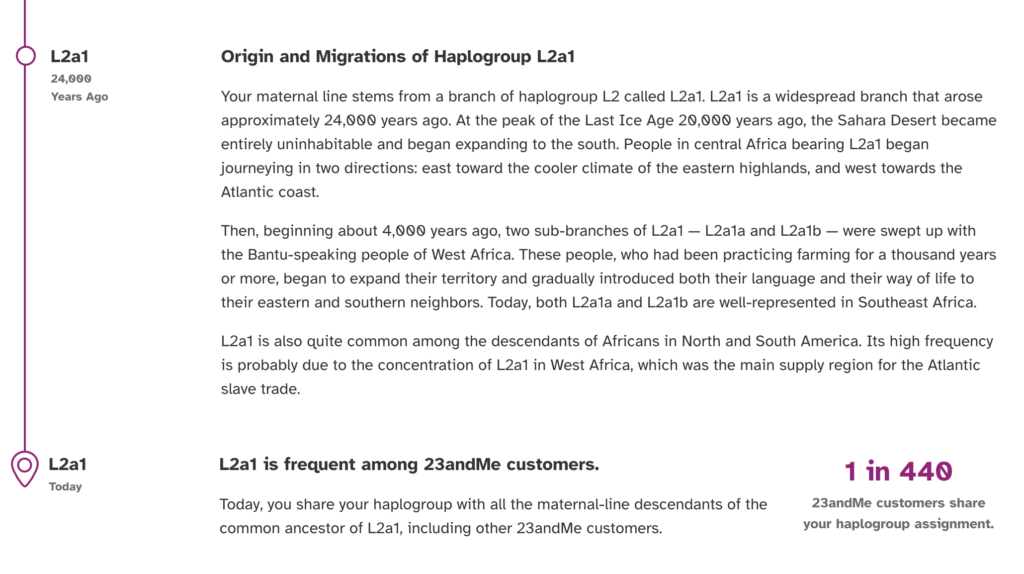One day while I was in college, a friend asked me a question that to this day has stuck with me. She asked me, “how far can you trace your maternal line?”. She very well knew I was into genealogy and that I could rattle off various names and generations but I still stopped to think, “Hmmm… counting my mom – six generations“. “And what about your paternal line?” she then asked. “Umm… actually six as well” I responded.
She was intrigued and so was I by this question and its potential answer. It turns out that she had just come back from a sociology/anthropology class where they were talking about men/women, and how (patrilineal) societies tend to lean more to remembering male ancestors versus female ancestors. She said that most of her classmates could not remember as many of their female ancestors in comparison to their male ancestors such as grandfather and great-grandfathers. Only one other student in class, a Hispanic student, remembered fairly well enough names in his direct maternal line. I told her I was not too shocked, and that our culture as Hispanics could potentially be helpful for this. Mainly because in a lot of the Hispanic world, women keep their maiden names and so their identities are not erased when they marry, coupled with the fact that most people have two surnames which they carry for the entirety of their lives.
Now in the 21st century, we can remember our ancestresses not only by their names but also through the matrilineal mtDNA lines we inherit from them as well. All humans inherit a maternal haplogroup from their mothers which is unlike a paternal haplogroup that can only be inherited by men from their fathers. This means that when you test, you can receive a maternal haplogroup from companies such as 23andme or FtDNA (if you take the maternal haplogroup test). My haplogroup comes from my mother and is an indigenous group – which I inherited from my mother, grandmother, great-grandmother, etc. Interestingly enough, my 2nd great-grandmother was the only daughter of the family which means that it is thanks to her descendants like my grandmother and mother that we know our line was C1b4. Haplogroups represent a tiny sliver of who you are because they show only a specific branch’s origin (not to be confused with autosomal DNA which is a combination of various ancestors and generations in your past).

I want to focus this post on combining DNA and traditional paper trail genealogy – using records to follow your branches in your family tree. Many people say that genealogy in Puerto Rico is difficult or impossible (I have posted before about 5 common myths in Puerto Rican genealogy). Though yes, it can be difficult, with a bit of legwork and some luck you can trace your family back far enough – and I want to demonstrate that today showing the farthest branch of women I have in my tree – nine generations of women going back to the early 1700s following my dad’s maternal line L2a1.
Generation 1
Carmen Veléz Avilés
So far there is not much information on my grandmother on the internet, and this is because she was fairly young and still is a part of a generation that genealogically is only just starting to appear on papers. My grandmother does appear in the 1950 census with her parents, Félix Vélez and Rosalía Avilés. My grandmother Carmen was born in 1940 but given that my grandmother was born after the census date, she does not appear until she is about 9-10 years old. I was able to meet my grandmother and I lived with her until I was about six years old but unfortunately I was not able to talk to her about genealogy and her life since she passed away both when she and I were fairly young. Nonetheless, I carry her legacy and her DNA with me everyday and can not wait to learn more about her on paper as more documents are later released.
Generation 2
Rosalía Avilés González
I was also able to meet my great-grandmother Rosalia Avilés González when I was a young kid, but I barely remember her. Likely my memories of her come from the pictures we took with her when we went to Lares, Puerto Rico when I was about 3-4 years old.
Rosalía was born in Río Prieto, Lares, Puerto Rico the 11th of June 1914. Her parents were José Avilés and Dionisia González. Her maternal grandparents listed on her birth record only lists her grandmother Antonia González, also living in Río Prieto, Lares, Puerto Rico.
From what I know, Rosalía never married my great-grandfather Félix Vélez Mercado and I currently have not found a marriage record for them either.
My great-grandmother passed away in 1994 in Lares, but I do not have her death record (something I should get my hands on!).

Generation 3
Dionisia González Padilla
My 2nd great-grandmother Dionisia González Padilla unfortunately lived a very short life, having her life cut short by the Spanish flu around the age of 26. Dionisia’s life is shrouded in a bit of mystery because to this date I have not been able to find her birth record.
I do, however, have her marriage record and death record to help support the information I know about her.
Dionisia González married José Avilés the 22nd July 1911 in Lares, Puerto Rico. Both José and Dionisia were natural children, meaning that their respective fathers did not recognize them at birth. José Avilés was the illegitimate son of Inocencia Avilés, while Dionisia González was the illegitimate daughter of Antonia González.

Dionisia would later die in Río Prieto, Lares the 10 December 1918 at 26 years old from the Spanish Flu. Her mother was listed as Antonia González, a native of Lares, 50 years old, single, and living in Río Prieto at the time of her daughter’s death.
Her grandparents in her death record are listed as Juan González and Severina Padilla, natives of Lares and both deceased by the time of Dionisia’s death.
Something to also notice is that in most records Dionisia is only listed as “Dionisia González” given that she was born out of wedlock. However, it seems that Dionisia’s father was a man named José Padilla who lived with Antonia González in 1910 in Lares and per the census claims Dionisia and her siblings as children. However, since José and Antonia were never married, Dionisia (rarely if at all) uses both surnames. I list her in my tree as “González Padilla” because she carried González throughout her life though Padilla was her father’s surname. This same case occurs with her husband José Avilés who should have carried “Magraner” as his father’s surname but never officially did since he was also born out of wedlock and thus appears in records and on my tree as “José Avilés Magraner”.

Generation 4
María Antonia González Padilla
Despite the fact that various records point to Antonia being from Lares, Puerto Rico we actually find her baptism in Yauco, Puerto Rico – a town south of Lares. María Antonia was born the 1st of July to her parents Juan González and Severina Padilla. Notice that she is listed as “hija legítima”, this means that her parents were married in the church before she was born.
Equally her grandparents are listed as well in her baptism record except for some reason it includes only the paternal grandparents. For the maternal grandparents they are listed as “se ignoran” (they are ignored). However, other records will provide us their names – In two baptism records for earlier children born in 1866 and 1868, the maternal grandparents are listed as Nicolás Padilla and Benita Santana.

We do not know when Juan González and Severina Padilla were married. María Antonia has two siblings born in Yauco as well in 1866 and 1868 so we know that her parents were likely married before 1866.
By 1910, Antonia is already living in Lares and this is where she will pass away in 1944. Her death record lists her husband as “José Padilla” who we have seen listed with Antonia González in the 1910 census, but who never officially recognized his children. Her parents are listed as Juan González and Severina Padilla and natives of Lares in this death record.

Generation 5
Ceferina Padilla Santana
At first it was tricky to find my 4th great-grandmother because her name has been spelled different ways such as Ceferina, Severina, and Seberina. But all of the variations lead me back to the same person. My 4th great-grandmother was baptized in Yauco the 20th November 1830 and born the 5th of said month.
Her parents were Nicolás Padilla and Benita Santana, no grandparents are listed in this baptism record.

Severina/Ceferina would also go on to live her life in Lares having passed away in Río Prieto, where my family lived up until the late 1930s. She is listed in her death record as the widow of Juan González with whom she had four children: Ramona, Antonia, Isabel, and Lorenzo. She is also listed as the legitimate daughter of Juan Nicolás Padilla and Benita Santana, natives of Yauco, and deceased.

Generation 6
Benita Santana Madera
My 5th great-grandmother, just like my 4th and 3rd great-grandmothers, was also born in Yauco, Puerto Rico.
Benita Santana Madera was born the 29th of August and baptized the 2nd of September 1801. Her parents are listed as Cosme de Sta. Ana (Santana) and Catalina de Madera. Her godparents were Martín de Sta. Ana (Santana) and Juana Quiñones. What’s interesting to note in her baptism is the “shorthand” form of Sta. Ana for Santana – literally Sta. meaning Santa and then Ana as if the surname was written as “Santa Ana” (Saint Ana) instead of “Santana”.

Benita similarly spent the rest of her life it seems in Lares, which makes me question why three generations of this branch were born in Yauco but then moved to Lares. She can be found living in Lares on a census taken in 1874. However, before moving Benita Santana married her husband Nicolás Padilla in Yauco, Puerto Rico.
Nicolás and Benita married in Yauco the 7th September 1826. Nicolás was the son of Ipolita (Hipólita) and Benita (listed incorrectly as Sánchez) was the daughter of Cosme and Catalina Madera.

Likely, Benita passed away before the Civil Registry was created in 1885 and after the Lares census was taken in 1874. This however leaves me with no death certificate for Benita Santana. This is because the Lares church records are not digitized and online FamilySearch like how Yauco is.
Generation 7
Catalina Madera Troche
Catalina becomes the first generation where documents start to become scarce. This likely occurs for a few reasons: 1) Catalina was born around the mid-late 1700s where documentation seems to become harder to find on the island and 2) she might have not been from Yauco herself. This means that currently I do not have a baptism record for Catalina.
Similarly, I do not have a marriage record for Catalina as well. Though it seems that Cosme Santana and Catalina Madera had quite a few children throughout their marriage, I can only find a baptism starting for their 8th children. The first baptisms in Yauco do appear in 1751 so either they are hidden amongst the pages or were baptized in another town all together before Child #8 was baptized in Yauco.

Despite the lack of records from Catalina’s earlier part of her life, I do have her death record. Catalina Madera Troche, the legitimate daughter of Vicente Madera and Ambrosia Troche was the widow of Cosme Santana when she passed away the 30th January 1822. She was about 60 years old at the time of her death (born circa 1762). In a lot of these older records children and grandparents are not listed so we have no more information on Catalina’s family from her death entry.
Generation 8
Ambrosia Troche del Espíritu Santo
My 7th great-grandmother was named Ambrosia Troche and from her death record we learn her second last name “del Espíritu Santo”.
As was the case with Catalina, I do not have much information on her so far. What I do have is the death record for Ambrosia in Yauco, Puerto Rico.

Ambrosia here appears as the widow of Vicente Madera and about 80 years old (born circa 1730). The issue though is that her last name is first listed as “Madera Troche” but then it states she is the daughter of “Manuel and Ana del Espíritu Santo”. Likely the mistake was made because her husband was indeed surnamed “Madera” but Ambrosia would herself would have been “Troche del Espíritu Santo”. In other records, and even on the margin of this one, she is correctly listed as “Ambrosia Troche”.
Interestingly enough, when Vicente and Ambrosia’s daughter Juana Madera Troche gets married in 1782, it listed one of the two women as being a native of San Germán – it seems like it is Ambrosia herself but the statement could also be referring to Juana Madera being a parishioner from San Germán. Nonetheless, this can likely explain why the family seems to pop up in Yauco only after some children are born and why they may be missing from records in Yauco. The next step would be to check San Germán’s baptism and marriage records to see if the family appears there.

Generation 9
Ana del Espíritu Santo
The last generation I have is the 9th generation and my 8th great-grandmother!! I only know of her name because of Ambrosia’s death record where she is listed as “Ana del Espíritu Santo”. If Ambrosia was born about the 1730s this would mean that Ana was likely born at the end of the 1600s or early 1700s depending on how off some of the dates are per generation. I have checked the Yauco death records between 1751-1770 and 1770-1785 but I have not been able to find a death record for Ana.
What is interesting to me is her last name “del Espíritu Santo” which would be translated as “from the Holy Spirit”. This is not a common name in Puerto Rican genealogy and I had never come across it until I saw it in my own family tree. The question becomes where does this last name come from? Could Ana have had no surname and she was just named “Ana del Espíritu Santo” (first and middle names) or could she have been previously enslaved and given a Christian surname? Many of the Yauco church books do not really state what the race of the couple or of the baptized children was and so it leaves you wonder what racial status they would have had in society at the time.
However, this is where genetics comes into play.
mtDNA - L2a1
We know that tracing this line back to the early 1700s and late 1600s via Ana del Espíritu Santo brings us closer to the ancestress that would have originally carried my father’s mtDNA haplogroup. As we can see via this line, many Puerto Ricans will likely come across a similar issue – where their ancestors have been on the island for so long that basically records begin to run out to point where their origin is from. Granted, yes, there are lines that came to Puerto Rico much later and thus can be easily found – most lines that are very, very old lines in Puerto Rico will likely have this similar situation happen to them. Fortunately, DNA is starting to give us a glimpse into the origin of those people who might remain paperless back in the 17th-16th century or until more records are released that may identify who they are.
According to 23andme, L2a1 is common amongst descendants of Africans in both North and South America and this is because the haplogroup can commonly be found in Western Africa, where slaves were taken from into the New World during the Atlantic Slave Trade. This leads me to believe that likely along this line I will find an African woman who was brought to Puerto Rico thus bringing along with her and leaving behind as genetic memory her mtDNA group L2a1. Her autosomal DNA will have played a role in my father’s genetic make-up, however, overtime depending on far back she is my father’s tree, he would have continued to lose her genetic make-up as more ancestors intermixed to make up who he is nine generations later. So though my father’s mtDNA is directly African, his autosomal DNA shows only 7.9% Sub-Saharan African, mostly all the segments are broken into small chunks across his chromosomes showing that it was introduced very early in.
Where to next?
As you can see, I am currently stuck in learning more about this family. However, I am proud that I have been able to trace this line basically to the 17th century, nine generations back – which is no easy feat!
My next step would be to begin digging in the San Germán church records to find families such as the Madera, Troche, and del Espíritu Santo. Unfortunately, the San Germán records are not online so I will not be able to look at them anytime soon.
I could also test my father with ftDNA for his maternal haplogroup to see what else I can find, but this would be a hyper focused research that I am fairly sure would not bare any fruit so far. I have had much difficulty with Y-DNA matching which typically is more commonly used on ftDNA so I can not imagine having any better luck with mtDNA.
Nonetheless, this is another example of how you can couple traditional paper genealogy and genetics to help you learn more about your ancestry and family tree.
Cover Photo Source: “Maternal Haplogroup”, 23andme (https://www.23andme.com/ : accessed 11 July 2022). Username and password of José Rivera privately held by Luis Rivera.

